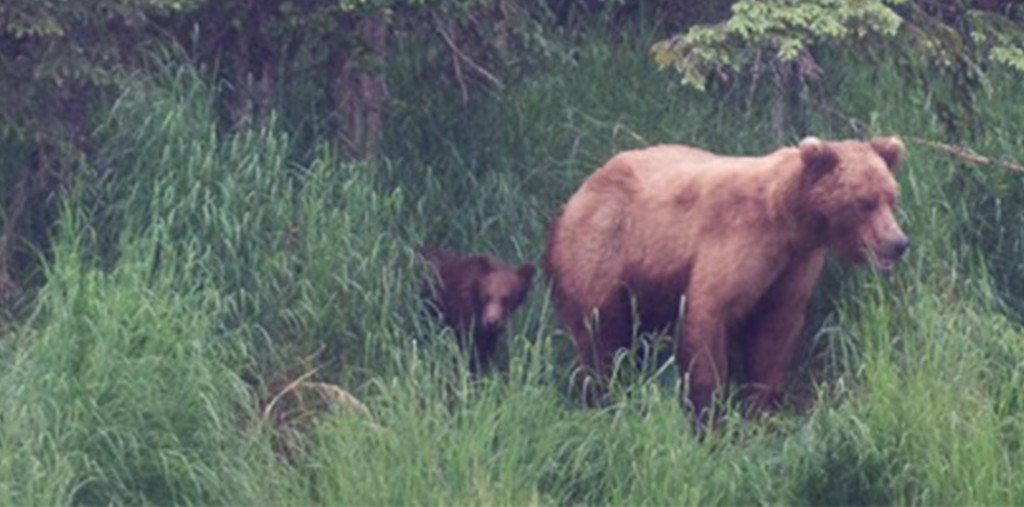By Mike Fitz
In a chilling rain, Katmai National Park ranger Andrew LaValle and I were just warming to the task of talking about Katmai’s 100th birthday. Established on September 24, 1918, Katmai National Monument has evolved from a place protected to study the effects of a violent volcanic eruption to one of the nation’s largest national parks, filled with abundant salmon, brown bears, and a rich human history.
We were both excited to share the tale of Katmai’s establishment as a protected area and how its significances have evolved over time. It remains a remarkable geologic landscape, but now Katmai is most well known for brown bears and biologists estimate over 2,000 inhabit the park. Our location for the broadcast, on a terrace overlooking a meander in Brooks River, is prone to being investigated by the park’s most famous residents. Andrew, a detail-oriented person, made sure to comment at the beginning of the broadcast about brown bears.
“This being a live broadcast it’s entirely possible…a bear could walk through the screen at any time. So if we have to exit or end the broadcast abruptly that’s probably why.”
The comment was a little prophetic.
The rainy morning’s dim light didn’t allow the camera to capture my reaction well, but I was quite surprised in that moment. (One person was off camera and tasked with watching for bears so we wouldn’t be surprised—so much for that!) Faced with a mother bear and her cub within 20 feet of us, we moved away, but not far. A specific set of circumstances dictated that we remain nearby.
First, we were in a group of three. Group size influences the risk of bear attack, and larger groups are safer near bears. This doesn’t eliminate the risk, but it does reduce it significantly. Second, the bear family showed no outward signs of defensiveness. Third, we needed to remain near our broadcast equipment. The latter remained especially important, not for us, but to protect the bears.
The bear family was 132 and her single spring cub. A cub’s time with its mother is short, typically just two to three summers in Katmai, so it needs to absorb her lessons as much as possible. Like children, bear cubs are curious and sponges for information. During travels as a family, cubs use their curiosity to investigate novel objects in their environment. Strange sights and smells often attract their attention and I watched this same cub pull unattended property from boats on two separate occasions this September.
By regulation, personal items must be attended at all times at Brooks River. This rule lessens the chances of bears damaging our stuff, but most importantly it prevents bears from learning that we have fun things to play with. If bears learn that our possessions can be used as toys, they may approach us or our buildings to try to get them from us. Bears who see people as sources of toys are bears who rangers will have to manage carefully, often through hazing and other aversive conditioning techniques (see pg. 22 of Katmai’s Bear-Human Conflict Management Plan for more information). For those reasons, we stood as a group next to the broadcast equipment, watching the bear family closely in case they showed defensiveness toward us or curiosity toward our possessions. Thankfully, they demonstrated neither, but their behavior may not have been reflective of a state of comfort either.
132 and her cub appeared to rest near us for several minutes, lying in the short grass. Outwardly, this might appear to reflect a certain level of relaxation. Inwardly, however, the bears may not have felt the same way. They likely weren’t lying there because they wanted to be near us. Alert to our presence as well as to other people nearby, 132 might have lied down because people were simply in her way—a group of humans with strange objects standing between them and the beach on Naknek Lake. She also might have experienced a physiological response to stress, like an elevated heart rate, not visible to us. A study of black bears in Minnesota demonstrated such a reaction in response to drones.
People aren’t aerial drones, I realize, so perhaps the comparison isn’t fair, but the bears probably wanted nothing more than space to themselves. Had I been alone, without the burden of vulnerable equipment, I would have most likely walked away from the family. At Brooks River, most bears are used to encountering people near the lodge and along the trails. While it’s often necessary to remain in place if a bear is showing signs of defensiveness or overt curiosity towards you, Brooks Camp has created a situation where frequent close encounters between people and bears have conditioned many bears to expect people to give them space. (This doesn’t necessarily apply in other areas, however. Please check with local rangers, biologists, and land managers for their advice.)
Under the circumstances, we decided remaining where we were was the safest and least stressful course of action for ourselves and the bears. It was an exciting few moments for Andrew and I—another remarkable example of how special Katmai really is and how complicated interactions with bears can be.



